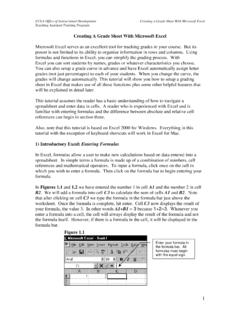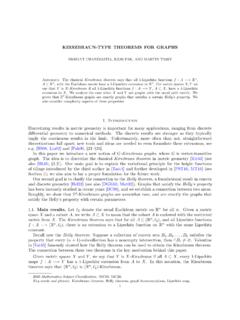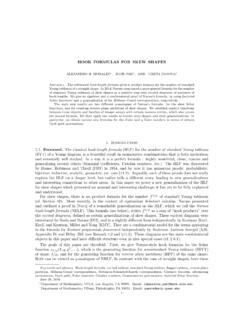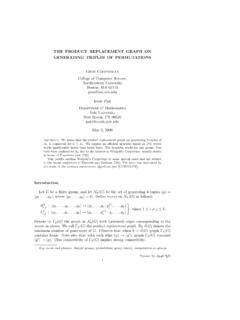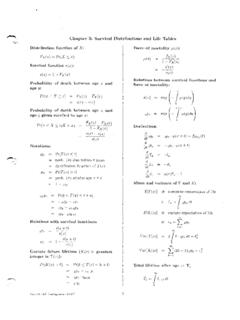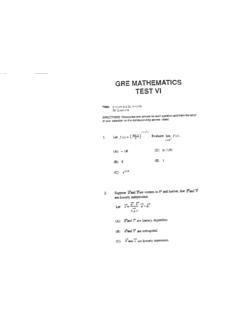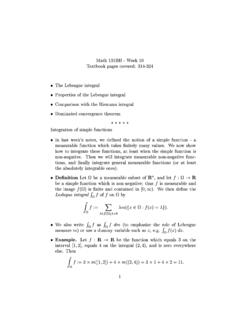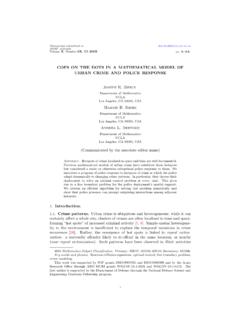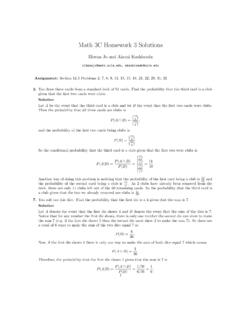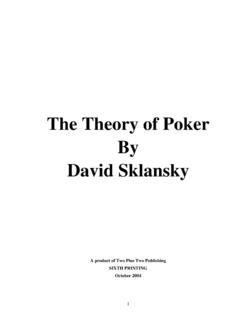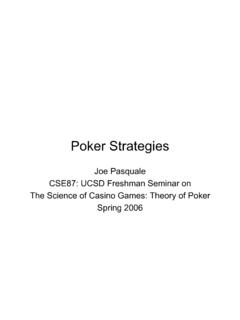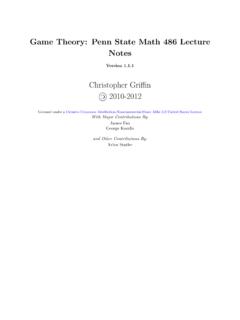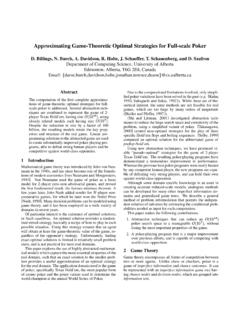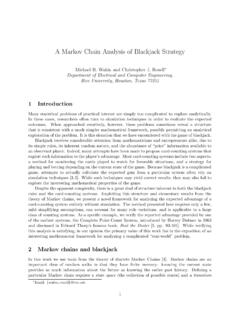Transcription of THE ENDGAME IN POKER - UCLA
1 THE ENDGAME IN POKER . Chris Ferguson, Full Tilt POKER Tom Ferguson, Mathematics, UCLA. Abstract. The simple two-person POKER model, known as Basic ENDGAME , may be described as follows. With a certain probability known to both players, Player I is dealt a hand which is a sure winner. If it is not a sure winner, then Player II is sure to have a better hand. Player I may either check, in which case the better hand wins the antes, or bet. If Player I bets, Player II may either fold, conceeding the antes to Player I, or call, in which case the better hand wins the antes plus the bets. This model is reviewed and extended in several ways. First, several rounds of betting are allowed before the hands are compared. Optimal choice of the sizes of the bets are described. Second, Player II. may be given some hidden information concerning the probability that Player I has a sure winner.
2 This information is given through the cards Player II receives. Third, the model is extended to the case where the hand Player I receives only indicates the probability it is a winner. This allows for situations in which cards still to be dealt may in uence the outcome. Introduction. In this investigation, we treat from a game-theoretic point of view several situations that occur in the game of POKER . The analysis of models of POKER has a long and distin- . guished existence in the game theory literature. Chapter 5 of the book of Emile Borel, Applications aux jeux de hasard (1938), and Chapter 19 of the seminal book on game theory by von Neumann and Morgenstern (1944) are devoted to the topic. In the 1950's, others developed further certain aspects of modeling POKER . Kuhn (1950) treats three card POKER . Nash and Shapley (1950) treat a three person POKER model.
3 Bellman and Blackwell (1949), Bellman (1952), Gillies, Mayberry and von Neumann (1953), Karlin and Restrepo (1957), Goldman and Stone (1960ab), and Pruitt (1961) extend various aspects of the POKER models of Borel and of von Neumann-Morgenstern further. Chapter 9 of the textbook of Karlin (1959) summarizes this development. For a more recent treatment of the models of Borel and von Neumann, see Ferguson and Ferguson (2003) and Ferguson, Ferguson and Gawargy (2007). Generally, the aim of such research is to analyze a simpli ed model of the game of POKER completely, with the hope of capturing the spirit of POKER in a general sense. Others have tried to analyze speci c situations or aspects of the real game with the hope that 1. it may improve one's play. Papers of Newman (1959), Friedman (1971), Cutler (1975, 1976), and Zadeh (1977), and the book of Ankeny (1981) are of this category.
4 On the other hand there are also books that contain valuable information and recommendations on how to play the real game of POKER . The books of Brunson (1978) and Sklansky (1987). on general games of POKER and of Sklansky and Malmuth (1988), Sklansky, Malmuth and Zee (1989), Zee (1992) and Harrington and Robertie (2004-2006) on speci c games of POKER can be recommended. Unusual in its treatment mixing mathematical analysis, game theoretic ideas and the real game of POKER , the book of Chen and Ankenman (2006) may be especially recommended. One of the simplest and most useful mathematical models of a situation that occurs in POKER is called the classical betting situation by Friedman (1971) and basic ENDGAME . by Cutler (1976). These papers provide explicit situations in the game of stud POKER and of lowball stud for which the model gives a very accurate description.
5 This model is also found in the exercises of the book of Ferguson (1967). Since this is a model of a situation that occasionally arises in the last round of betting when there are two players left, we adopt the terminology of Cutler and call it Basic ENDGAME in POKER . This will also emphasize what we feel is an important feature in the game of POKER , that like chess, go, backgammon and other games, there is a distinctive phase of the game that occurs at the close, where special strategies and tactics that are analytically tractable become important. 1. Basic ENDGAME . Basic ENDGAME is played as follows. Two players, Player I and Player II, both put an ante of a dollars into a pot (a > 0). Player I then draws a card from a deck of cards that gives him a winning card with probability ( ) P and a losing card 1 P , 0 < P < 1.
6 Both players know the value of P , but only Player I knows if the card he received is a winning card or not. Player I may then check (also called pass) or bet b dollars (b > 0). If Player I checks, the game is over and the antes goes to Player I if he has a winning card and to Player II otherwise. If Player I bets, Player II may then fold, or she may call by also putting b dollars in the pot. If she folds, then Player I wins the ante whatever card he has. If Player II calls, then the ante plus the bet is won by Player I if he has a winning card and by Player II otherwise. Only the ratio of b to a is signi cant, but we retain separate symbols for the ante and the bet so that the results are easier to understand. Situations of the form of Basic ENDGAME arise in POKER . For example, in the last round of betting in a game of ve card stud POKER , Player I's cards are the 5 of diamonds, the 6 of spades, the 7 of diamonds, the 8 of hearts and a hidden hole card.
7 Player II's cards are the 2 of hearts, the 3 of spades, the king of spades, the king of clubs and a hidden hole card. No matter what card Player II has in the hole, Player I will win if and only if he has a 4 or a 9 in the hole. Since Player II has the higher hand showing, she must act rst by betting or checking. In this situation, it is optimal for her to check. Assuming she does check, it then becomes Player I's turn to act, and we have a situation close to Basic ENDGAME described in the previous paragraph. The number a may be taken to be half the size of the present pot, and b will be the maximum allowable bet. The number P is taken 2. to be the probability that Player I has a winning hole card given the past history of the game. There are several reasons why Basic ENDGAME is not a completely accurate description of this POKER situation.
8 In the rst place, the probability P , calculated on the basis of three rounds of betting before the nal round and the actions of the players in these rounds, is an extraordinarily complex entity. It would be truly remarkable if both players arrived at the same evaluation of P as required by Basic ENDGAME . Secondly, Player II's hole card gives her some secret information unknown to Player I that in uences her estimation of P , and both Player I and Player II must take this into account. In Section 5, we extend the model to allow for this hidden type of information. Thirdly, a player may unknowingly give away information through mannerisms, hesitations, nervousness, etc. This type of hidden information, called tells , (see Caro (1984)) is of a di erent category than information given by a hidden hole card. The player who gives away such information has no way of taking this into account since he is unaware of its existence.
9 Another way this type of hidden information can arise is through cheating. For example, someone may gather information about the cards through a hole in the ceiling and pass this information to one of the players at the table. (Don't laugh this happened at one of the casinos in California.) Such games in which one of the players does not know all the rules of the game, are called pseudo-games, and have been studied by Ba nos (1968) and Megiddo (1980). The extensive literature on repeated games of incomplete information ( see Aumann and Mashler (1995) or Sorin (2000)) is also an attempt to treat this problem. If Player I receives a winning card, it is clear that he should bet: If he checks, he wins a net total of a dollars, whereas if he bets he will win at least a dollars and possibly more. In the analysis of the game below, we assume that Player I will bet with a winning card.
10 The rules of the game may be summarized in a diagram called the Kuhn tree, a device due to Kuhn (1953). Figure 1 gives the Kuhn tree of Basic ENDGAME . It is to be read from the top down. The rst move is a chance move with probabilities P and 1 P attached to the edges. Then Player I moves, followed by Player II. The payo s to Player I are attached to each terminal branch of the tree. The only features not self-explanatory are the circle and the long oval. These represent information sets. The player whose turn it is to move from such a set does not know which node of the set the previous play has led to. Thus the long oval indicates that Player II does not know which of the two nodes she is at when she makes her choice, whereas the circle indicates that Player I does learn the outcome of the chance move. In this situation, Player I has two possible pure strategies: (a) the blu strategy bet with a winning card or a losing card; and (b) the honest strategy bet with a winning card and check with a losing card.

